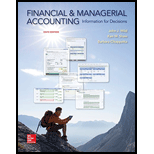
Break-even Point:
The break-even point is the amount of sales that does not result in any loss or profit for a company. It is used for the various cost control goals as it covers the total cost of operation that would be incurred.
To identify: The break-even point.
Explanation of Solution
In order to calculate the break- even point, contribution margin needs to calculate.
Given,
The sale price per unit is $90.
The variable cost per unit is $36.
Formula to calculate the contribution margin,
Substitute $90 for sales per unit and $36 for variable cost per unit.
The contribution margin per unit is $54.
The fixed cost is $162,000. (Given)
The contribution margin per unit is $54. (Calculated in equation (1))
Formula to calculate the break-even point,
Substitute $162,000 for fixed cost and $54 for contribution margin per unit.
Hence, the break-even point is 3,000 units.
1. Total fixed cost increased to $190,000.
In order to calculate the break- even point, contribution margin needs to calculate.
The fixed cost is $190,000. (Given)
The contribution margin per unit is $54. (Calculated in equation (1))
Formula to calculate the break-even point,
Substitute $190,000 for fixed cost and $54 for contribution margin per unit.
Hence, the break-even point is 3,519 units. As the break-even point has increased the answer will be (I).
2. Variable cost decrease to $34.
In order to calculate the break- even point, contribution margin needs to calculate.
Given,
The sale price per unit is $90.
The variable cost per unit is $34.
Formula to calculate the contribution margin,
Substitute $90 for sales per unit and $34 for variable cost per unit.
The contribution margin per unit is $56.
The fixed cost is $162,000. (Given)
The contribution margin per unit is $56. (Calculated in equation (2))
Formula to calculate the break-even point,
Substitute $162,000 for fixed cost and $56 for contribution margin per unit.
Hence, the break-even point is 2,893 units. As the break-even point has increased the answer will be (D).
3. Selling price per unit decrease to $80.
In order to calculate the break- even point, contribution margin needs to calculate.
Given,
The sales per unit is $80.
The variable cost per unit is $36.
Formula to calculate the contribution margin,
Substitute $80 for sales per unit and $36 for variable cost per unit.
The contribution margin per unit is $44.
The fixed cost is $162,000. (Given)
The contribution margin per unit is $44. (Calculated in equation (3))
Formula to calculate the break-even point,
Substitute $162,000 for fixed cost and $44 for contribution margin per unit.
Hence, the break-even point is 3,682 units. As the break-even point has increased the answer will be (I).
4. Variable cost increased to $67.
In order to calculate the break- even point, contribution margin needs to calculate.
Given,
The sales per unit is $90.
The variable cost per unit is $67.
Formula to calculate the contribution margin,
Substitute $90 for sales per unit and $67 for variable cost per unit.
The contribution margin per unit is $23.
The fixed cost is $162,000. (Given)
The contribution margin per unit is $23. (Calculated in equation (4))
Formula to calculate the break-even point,
Substitute $162,000 for fixed cost and $23 for contribution margin per unit.
Hence, the break-even point is 7,044 units. As the break-even point has increased the answer will be (I).
5. Total fixed cost decreased to $150,000.
In order to calculate the break- even point, contribution margin needs to calculate.
The fixed cost is $150,000. (Given)
The contribution margin per unit is $54. (Calculated in equation (1))
Formula to calculate the break-even point,
Substitute $150,000 for fixed cost and $54 for contribution margin per unit.
Hence, the break-even point is 2,778 units. As the break-even point has increased the answer will be (D).
6. Selling price increased to $120
In order to calculate the break- even point, contribution margin needs to calculate.
Given,
The sale price per unit is $120.
The variable cost per unit is $36.
Formula to calculate the contribution margin,
Substitute $120 for sales per unit and $36 for variable cost per unit.
The contribution margin per unit is $84.
The fixed cost is $162,000. (Given)
The contribution margin per unit is $44. (Calculated in equation (5))
Formula to calculate the break-even point,
Substitute $162,000 for fixed cost and $84 for contribution margin per unit.
Hence, the break-even point is 1,929 units. As the break-even point has increased the answer will be (D).
Want to see more full solutions like this?
Chapter 18 Solutions
Financial and Managerial Accounting: Information for Decisions
- Morris Manufacturing is allocating $90,000 in inspection costs to its two suppliers using the number of inspections as the activity driver. Supplier X: 15 inspections Supplier Y: 45 inspections How much of the cost should be assigned to Supplier Y?arrow_forwardcorrect solution accounting questionarrow_forwardCrane Inc. reports: • Net Income $250 million Average Total Assets = $2,500 million What is the ROA?arrow_forward

 AccountingAccountingISBN:9781337272094Author:WARREN, Carl S., Reeve, James M., Duchac, Jonathan E.Publisher:Cengage Learning,
AccountingAccountingISBN:9781337272094Author:WARREN, Carl S., Reeve, James M., Duchac, Jonathan E.Publisher:Cengage Learning, Accounting Information SystemsAccountingISBN:9781337619202Author:Hall, James A.Publisher:Cengage Learning,
Accounting Information SystemsAccountingISBN:9781337619202Author:Hall, James A.Publisher:Cengage Learning, Horngren's Cost Accounting: A Managerial Emphasis...AccountingISBN:9780134475585Author:Srikant M. Datar, Madhav V. RajanPublisher:PEARSON
Horngren's Cost Accounting: A Managerial Emphasis...AccountingISBN:9780134475585Author:Srikant M. Datar, Madhav V. RajanPublisher:PEARSON Intermediate AccountingAccountingISBN:9781259722660Author:J. David Spiceland, Mark W. Nelson, Wayne M ThomasPublisher:McGraw-Hill Education
Intermediate AccountingAccountingISBN:9781259722660Author:J. David Spiceland, Mark W. Nelson, Wayne M ThomasPublisher:McGraw-Hill Education Financial and Managerial AccountingAccountingISBN:9781259726705Author:John J Wild, Ken W. Shaw, Barbara Chiappetta Fundamental Accounting PrinciplesPublisher:McGraw-Hill Education
Financial and Managerial AccountingAccountingISBN:9781259726705Author:John J Wild, Ken W. Shaw, Barbara Chiappetta Fundamental Accounting PrinciplesPublisher:McGraw-Hill Education





